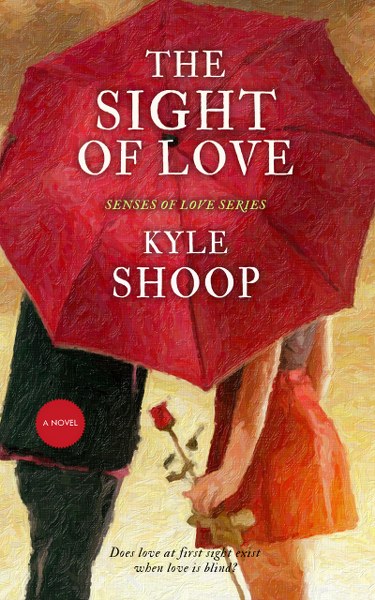The Sound of Love
Senses of Love Book 1
by Kyle Shoop
Genre: Contemporary Romance
Words than can't be spoken can still be sung.
Sometimes the most beautiful relationships between two individuals blossom from moments of tragedy.
Charlotte and John grew up as young orphans in the secluded outskirts of a rural town. Each day, they’d sneak out to the nearby forest to escape the cold grasp of the orphanage’s tyrant-ruler, by creating an imaginary kingdom together. However, their worlds, and the safety that came from their friendship, were suddenly ripped apart when they got caught.
Years later, Charlotte conquered the marketing world in downtown Portland. Having gained normalcy in her life since her days in the orphanage, Charlotte never expected her world to be turned upside down by John abruptly being thrust back into her life.
However, the years since the orphanage had not at all been kind to John, leaving him unable to open up to Charlotte about the details. So, she reignites John’s love for playing music, finding that his songwriting is the only way to help him express what he otherwise has difficulty saying. But in doing so, the reunited couple discovers that John’s love for music may not have been the only fire waiting to be rekindled.
Would what began as two children playing in the woods in the heart of tragedy blossom into long-awaited, and much desired, love?
Chapter 1
One of the common tragedies in life is seeing the world
around you degrade as time forges on. Eventually age may not
be seen as an accomplishment, but instead an unyielding
reminder that life will never again be as you once knew it. The
places that used to remind you of home subtly change with time
into a rustic ruin of familiarity. Those scenic images enshrined
as memories of significant moments in your life fade along with
your recollection of those memories. In time, the past that you
may have once cherished as treasured or ideal eventually
becomes an unrelenting reminder that the future will be a lot
less memorable.
But not for Charlotte – not at all. For her, the past was
not cherished, nor was it memorable. Rather, she had often
gone to excruciating lengths to forget her past. Once, she
stumbled upon a photograph in the newspaper of where she’d
grown up. Whether out of retaliation or an instinct for survival,
she set it afire, hoping that any memories she still had of the
place would also dissipate into the air along with the ashes of
the photograph. She then cancelled her newspaper subscription.
Charlotte’s life was the antithesis of human nature.
Indeed, it was the antithesis of nature itself. In college, she’d
learned about a law of nature called entropy. Under this law,
everything loses energy and degrades over time. Matter falls
away from each other into a lesser, more-chaotic state of
existence. Charlotte instantly rejected this idea and consciously
determined at that moment to do everything within her power
to avoid this from occurring in her life. She had to. If she was
to allow entropy to occur at all for her, then she might as well
be homeless. This is because homelessness was the natural step
from where she’d grown up.
So, rather than embracing the hopelessness of the natural
trajectory of her life, Charlotte instead did everything she could
to succeed. She declared a major at that same college, naturally
science. She then spent all of her time holed up in the campus
library focusing on educational success instead of allowing
herself to succumb to the temporary happiness that the other
girls sought in relationships or friendships. At nineteen years
old, she was the youngest person in her college’s graduating
undergraduate class. But nineteen was much too young to be
able to seriously jump into the workforce with any ability to
earn the salary that she knew she deserved, and which would be
necessary to pursue the financial successes that she thought
she’d earned. With her hard work, Charlotte became married to
the fact that she was deserving of a successful life. Not because
she was entitled to it or even belonged in that social arena, but
because she knew that she could attain it. She knew that she
was worth it, even if the laws of nature disagreed. And she was
willing to sacrifice all other aspects of her life to obtain what
she knew nature did not want her to achieve.
For this reason, Charlotte declared her graduate degree in
marketing rather than science. She was not naive; she knew she
somehow lucked out in being attractive. If there was one thing
gifted to her from birth, she recognized that was it. With her
tall, gracefully slender appearance, Charlotte also knew she’d
easily get an entry-level position in almost any marketing firm in
any large city. And once she got it with her looks, she was
confident that she’d then be able to impress the decisionmakers
with her wit and hard work to quickly reach maximum
earning potential. This is what she desired, but also what she’d
strived so hard to achieve to avoid entropy. Always, in the back
of her consciousness, was the self-doubt that she actually
belonged in the company of those decision-makers. She truly
believed that nature had selected her trajectory as eventually
being homeless, and she had cheated it.
Perhaps that was why she despised her short, daily
commute to her downtown office at the marketing firm which
she’d chosen to conquer. She wasn’t sure why she’d chosen
Portland for where she’d begin her career. Perhaps it was
because the city was up-and-coming and becoming modern.
Perhaps it was because the idea of conquering a larger city like
Chicago or Los Angeles was too daunting. Or perhaps it was
because of its close proximity to where she was originally from
in Battle Ground, Washington. That’s right – she grew up in a
battle ground, in all senses of the word.
But location had nothing to do with why she loathed her
drive to and from her office each day. Rather, that had
everything to do with Pioneer Square.
It was necessary to drive by some corner of Pioneer
Square to reach her building located just across the street from
the corner of that depressing city center. So, it was inevitable
that her morning each day would begin with seeing the
multitude of homeless men and women that congregated at
Pioneer Square. And at the end of a long work day, her evening
every night would conclude the same way as her day had begun
– by driving by that same dreadful square.
If Portland and its suburbs were becoming the modern,
happening location for young adults, then that modernization
was forcing the area’s homeless into the middle of the city. And
that middle was Pioneer Square. It didn’t matter if it was the
heat of summer or the dead-cold of winter, there were always
homeless people using Pioneer Square as their temporary home.
But it wasn’t actually the homeless individuals themselves
that Charlotte despised. Indeed, over the past year, she had
become visually familiar with the regulars. She began to
recognize many of their faces, and even looked forward to
seeing them throughout the week – so as to provide her with
the assurance that they were surviving despite the difficult
circumstances that they’d been given in life.
Over time, she’d recognize faces disappear from the
corner. It was sporadic and random with who would disappear,
and Charlotte never knew why. She began making stories up
about what the disappearing faces’ fates were, even though it
was just a ruse to shield her from reality. She’d imagine that
some of them decided to travel to other, larger cities – hoping
to start over anew there. Others were found by distant relatives
and provided an opportunity to improve their situation. And a
lucky few were fortunate to have found a selfless stranger who
would gift them with a new life – as if they had won the lottery.
Maybe one or two of them even struck it luckier and found
someone from a wealthier class to start their life with anew,
who saw them for who they really were on the inside despite
their unfortunate life circumstances.
Though these were all fantastical stories Charlotte would
imagine about complete strangers, they were all made up
dreams to avoid what she knew was the likely outcome of
several of the unfortunate individuals who had stopped
congregating at Pioneer Square. It would seem to many that
being homeless is the low point in life, but Charlotte knew that
the majority of people would stop being at Pioneer Square for
just that reason – because the loss of life was the natural next
step from homelessness under the law of entropy. And if
Charlotte knew that she really belonged on that street corner
among her true peers, then she knew what the forces of nature
really wanted her ultimate fate to be. She was determined, at all
costs, to avoid this.
But on this cold, late January evening, Charlotte sat in her
warm, luxurious car on her way home. The stop light seemed to
linger on red longer than normal. The hue of the red light
pulsed behind the backdrop of snow being wiped off of her
windshield repeatedly from the cascading rate at which it fell.
The rhythm of the windshield wiper seemed as if it would never
end, and Charlotte’s internal pull toward Pioneer Square
intensified. As if drawn by natural instinct, she peered at the
square just to the right of her stopped car, wondering which of
the familiar homeless she would see battling to brave the bitter
cold that night.
Then she saw him. A new face. Actually, two new faces.
But it wasn’t the fact that there were two new faces which
ignited her impulse to immediately get out of her car. One of
those faces was a first for her. One of those faces was a
homeless child.
The Sight of Love
Senses of Love Book 2
Does love at first sight exist when love is blind?
Ethan was born to paint. His pursuit of beauty and meaning through art was the only thing his heart desired above all else. Until he met Rose.
It was love at first sight. A love which was as inspiring and captivating as the delicate life which radiated from a fresh rose. Her sight intoxicating. Her personality angelic. Her love instantaneous and unselfish.
But was that love enough to last a lifetime? Art often requires sacrifice. But Ethan’s life wasn’t just full of sacrifice for his passion, it would become marked with significant loss. An unforeseeable loss beyond his control and undercutting all which he sought in life.
Each moment of life is just a brush stroke in a larger painting. Would the love between Ethan and Rose be just the first brush stroke, or instead the reason to keep painting?
Experience the second book in the compelling “Senses of Love” series.
Chapter 1
The key is not in the light, it’s in the darkness. The
shadows. Sometimes it’s in the shadows where true beauty is
hidden. Indeed, without accurate shadowing, the depth of a
painting may not truly be felt, no matter how perfectly the
lighting is depicted. It’s the dichotomy between light and dark
which allows the fullness of the image to be revealed. Ethan
recognized this at an unusually young age and, at first, spent
much of his time perfecting the shadowing of his paintings.
He began painting young, having learned basic techniques
by tracing the outlines of other famous works. He never really
stopped to analyze why he was so fiercely drawn into being an
artist. As Ethan got older, he’d think about kids who were
naturally gifted with the ability to sing, and figured that they
were just born knowing that singing was their calling in life.
Ethan was a little different though. Looking back, he didn’t see
himself as being gifted from birth with the ability to paint. And
he didn’t see painting as his only calling in life. Rather, he just
knew that he really wanted to do it. Always. He couldn’t
remember a time where he wasn’t studying other painters,
practicing it, or actually painting a commission. He just always
wanted to paint.
His parents certainly didn’t foster this skill in him, but
thinking about his parents was just about the last thing Ethan
ever wanted to do. He’d rather have watched an infant draw
with mashed up peas instead of think about his parents. At least
something compelling might randomly appear from the chaos
of smeared peas, whereas his relationship with his parents was
the antithesis of compelling.
Though Ethan was always intrigued by visual arts, his
desire to actually try painting began at only eight years old. He’d
managed to sneak from his parents that he was going to try
painting. He’d find copies of famous works and hide them in
his room, tracing the outlines when the rest of his family left
him alone – which was often. Pretty soon after he started with
tracings, he full-on painted rudimentary recreations. It took
quite some time, but these recreations peaked with a miniature,
but substantially similar, recreation of Vincent van Gogh’s The
Starry Night. From afar, an amateur wouldn’t have noticed the
difference between the original painting and Ethan’s recreation.
By the time he finished it, he was only nine years old. But
despite manifesting such a unique talent for mimicking the
iconic painting at such a young age, that was the last time Ethan
ever did a recreation. This was simply because the painting
didn’t challenge him enough.
He’d spent months studying the original classic’s brush
strokes and mixtures of coloring in the paints. He was
obviously significantly more advanced in his attention to detail
than even teenage painting enthusiasts. But it wasn’t Van
Gogh’s actual painting style which he didn’t find challenging
enough. Definitely not. He loved that famous painting -
everything about it. Rather, it was the fact that he didn’t create
it himself. As much as he admired several famous paintings,
Ethan quickly learned that mirroring another artist’s work was
just not compelling enough for him.
Still, he learned much from his hands-on study of
shadowing in The Starry Night. The shadows in that famous
work seemed so simple and overlooked at first. He knew that
the average eye would be drawn to the light from the swirling
glow of the night sky. But Ethan recognized right away that it
was the contrast between those lights and the shadowing of the
earth below which allowed the word “beautiful” to accurately
convey emotions that were aroused from staring at that great
work of art. At only nine, Ethan barely even knew what
“beautiful” meant, since he rarely ever heard his parents speak
anything close to it. But, still, the first time he saw the painting,
“beautiful” was the only word that somehow instinctively came
to mind.
And Ethan wanted to arouse that same feeling of beauty
in others – only, from his own creations.
Unfortunately, the impressionist style depicted from Van
Gogh’s painting would not be the artistic style he would use to
evoke such emotion. Besides learning the importance of
shadowing from it, there was one other prominent thing that
stood out to Ethan from his tedious recreation of The Starry
Night: impressionism was hard to paint!
The impressionist style wasn’t one which depicted a
realistic, exacting recreation of a scene. Rather, it used a realistic
recreation as a baseline, then sought to focus on the emotion of
the scene through a subjective approach. This often resulted in
blurred, swirling, or large-brushstroke styles. There really wasn’t
a unified mechanism for drawing an impressionist painting.
Rather, if there was a unifying trait, it was to focus on the
emotion of a scene instead of how realistic it looked. This often
resulted in exaggerated uses of color and style. And this style
was just too difficult for Ethan to create. It may have been due
to his young age and just starting to cope with emotions, but his
intimidation with the style proved a mental hurdle from
reattempting to paint an impressionist creation for many years
to come.
So eventually, and with the suggestion of a prominent
artist whom he lucked into meeting, Ethan switched to a lessprevalent
style known simply as romanticism. By the time
Ethan was made aware of this style, he was ten years old. So, he
was too young to be drawn to the style for any actual romantic
aspirations. No, he was drawn into it because of the heightened
focus on shadowing which that style more obviously utilized …
and because the first painting he’d seen from the romantic era
made him think of Robin Hood! As a ten-year-old, Ethan
definitely knew who Robin Hood was, and thought any style of
painting that seemed to depict that awesome figure was worthy
of his time.
The first romantic painting he had run across was at an
art gallery in downtown Atlanta. As was his weekly habit, Ethan
would follow his father into the city pretending to want to learn
his father’s profession in neurosurgery. Four days a week, his
father would study his cases from his office in their upscale
house in the rich suburbs of Atlanta. But once a week, on every
Friday, his father would travel into the city to meet with his
next patient or to actually perform an expensive brain surgery at
the hospital. Ethan reveled in that weekly trip to downtown
Atlanta – not because he wanted to learn about his father’s
profession, but because he utilized the trips as opportunities to
study paintings from the local prominent art gallery. The only
thing was his parents – and especially his father – didn’t know
about these self-guided field trips. Just like he hid his
recreations and love for painting from his parents, he kept the
purpose of traveling with his father to himself.
Each time his father travelled into the city, Ethan tagged
along. He’d feign interest in his father’s profession during the
day, which naturally sparked his father’s enthusiasm that his son
would follow in his footsteps. His father, Russell Cooley, was a
prominent neurosurgeon. Unfortunately, along with this
prominence came not only pride, but also an unyielding
perspective of practicality. And art – any form of it – is the
antithesis of practicality.
This led to deceit by Ethan. Deceit by omission, more
specifically. During the morning and later afternoons, Ethan
would sit in his father’s study at the hospital, pretending to be
interested by the dreariness of the scientific culture upon which
medicine was practiced. Painting was the only science that
existed to the young boy. Ethan waited and waited for the one
hour he had each week to study his own passion. The lunch
hour.
Right before noon each day, Russell would hand Ethan
enough money for Ethan to go buy them both lunch. Luckily
for Ethan, his father ate the same thing each day from the same
store. And that restaurant was just down the street from
Buckhorn Art Company. This is where the deception
manifested. Ethan never ate lunch on Fridays, thus
unintentionally embodying the phrase “starving artist” from a
young age. Instead, he learned that if he ran down to get his
father lunch, then he would normally have about forty minutes
to stop by the art gallery before needing to be back at his
father’s office at the end of the lunch hour. By not eating, he
earned himself another five minutes or so studying all of the
classics, as well as some of the modern paintings, hanging in the
nearby gallery.
Buckhorn Art Company was not just an art gallery, it was
a school. Due to this, the company owner and wellaccomplished
local artist, Eugene Turner, kept several halls
reserved hanging exact replicas of classical paintings. Eugene
charged the public for admission into the gallery. But after a
couple of months, he caught onto Ethan’s motive. It wasn’t
Ethan’s routine visits which Eugene caught onto first – it was
Ethan’s pellucid passion for the art.
This passion manifested immediately the first time that
Eugene talked to him about the works of art hanging in the
halls with the classic paintings. Those halls were not only a
timeline of the evolution of painting, but also a visual depiction
of the struggles and triumphs of mankind.
From their first conversation together, it struck Eugene as
peculiar that the first thing Ethan mentioned was the
shadowing of a painting. Never before had Eugene ever had
someone point out shadowing as their favorite part of any
painting, not even from the self-proclaimed professional artists
who frequented the distinguished gallery.
“Are you sure – the shadowing?” Eugene asked Ethan.
“Oh, definitely. Look at it!” Ethan responded, fixated on
the well-known work of art in front of them.
“… but it’s a can of soup.” Eugene was obviously
skeptical that anyone could actually find beauty in the
shadowing of Andy Warhol’s Campbell’s Soup Can painting.
Ethan started to explain himself, but Eugene wasn’t going to
allow it. “Here, follow me.” He was going to test the boy.
Eugene took Ethan to observe the painting by Edvard
Munch entitled The Scream. It was a famous painting that
Ethan had stood in front of several times studying the feelings
it evoked. Visually, it reminded Ethan of The Starry Night, so
he’d naturally been drawn to this similar work many times
before.
“What do you like about this painting, huh? What about it
moves you?” Eugene intentionally asked the question broadly,
trying not to steer the boy towards its shadowing.
“Well, just look at it.” Ethan instantly answered, almost as
if he’d studied this painting already so much that he was waiting
for someone to ask him about it. “It makes the entire painting,
doesn’t it?” He asked rhetorically out loud. The boy was so
captivated by the artwork that he didn’t even look at Eugene
right next to him.
“What? What makes the painting?” Eugene pressed.
“It’s the same thing – the shadowing.” There it was. That
same answer from such a young boy. Eugene was about to ask
for more details about what the boy meant, but he didn’t have
to. Ethan couldn’t withhold his enthusiasm for his perspective
of this great work. “I mean – it provides the foundation for the
entire painting. It’s only because the body of the person
screaming is in the shadows that the scream is felt so intensely.
It’s as though you can hear the scream even though it’s really
just a painting. Oh, and the shadowing on the dock provides
such depth, making the scream feel real.”
“Okay, just stop.” Eugene interrupted. “Who taught you
this?”
“Taught me?” Ethan was confused.
“Boy, have you ever taken an art class before?”
The boy wasn’t sure how to answer. He was embarrassed
because he hadn’t. And he thought that the owner of the great
Buckhorn Art Company would think less of him because of he
lacked an education in the one thing that he wanted so badly.
But the boy didn’t have to answer. Ethan’s pause of
silence and look of embarrassment told Eugene enough.
“What’s your name, boy?”
“Ethan Cooley.”
“Well, Ethan, my name is …”
But before the man could say his name, Ethan
interrupted: “Eugene. I know who you are. I’ve seen your
paintings in here – they’re amazing.”
Eugene was even more shocked by how Ethan had
observed so much about painting in just the short amount of
hours he’d been in the gallery throughout the last couple of
months. To Eugene, this wasn’t just a coincidence. This meant
something – something which he couldn’t pass up.
Eugene just stared at The Scream for a moment. He
wasn’t deciding what he should do next, but how he should do
it. When a thought came to him, he instructed the boy: “Here,
follow me to this one.”
They both walked down to a different hall, as if rewinding
in time a bit to a different stylistic era.
“Ethan, this one is entitled The Kiss, by Francesco
Hayez.”
Ethan just stared, intrigued by it. He’d probably seen it
before, but only in a passing moment. He’d always favored the
impressionist paintings more than the romantic-era paintings
like this one. But, upon really noticing this painting for the first
time, something very specific about The Kiss stood out to him.
In the middle of the painting stood a couple kissing in a stone
hallway. The woman wore a blue dress, and the man stood over
her, passionately embracing her. Again, though, Ethan was too
young to be moved by the romantic passion of the couple.
Instead, he was interested in it for another reason that was
obvious to about any boy his age. The man in the painting had
a cape and hat on that looked just like Robin Hood.
“Wow, that’s so cool …” Ethan said to himself, trailing
off in thought as he really studied it for the first time ever.
“And look at the shadowing of the couple. It’s so realistic and
well-done.”
“Can you still feel the emotion from the painting just as
clear as you can hear the scream in the other one?” Eugene
asked.
What Eugene just asked made Ethan pause for a moment.
He’d never really considered before that a romantic style
painting could depict the same emotion he’d felt from the
impressionist paintings. But it did, and he liked it. Even then,
there was something even more alluring about this style to
Ethan – it would definitely be easier for him to create his own
painting in it than the intimidating impressionist style.
“Yes.” Ethan said directly.
“Good, I’m glad you like it.” Eugene remarked.
“But why are you showing it to me?”
“Because, Ethan, I’m personally going to teach you how
to paint like it.”
Kyle Shoop is a multi-genre author of compelling stories. His new "Senses of Love" series is a romance series that provides rewarding and inspirational stories.
Kyle is also the author of the Acea Bishop Trilogy, which is an action-packed fantasy series. All books in that series are now available, with Acea and the Animal Kingdom being the first book.
At a young age, Kyle was recognized for his storytelling by being awarded the first-place Gold Key award for fiction writing in Washington State. After spending several years volunteering in his wife's elementary classrooms, he was inspired to write the Acea Bishop Trilogy. He is now motivated to finish his the new romance series. In addition to writing novels, Kyle is also a practicing attorney.
Kyle and is wife and two children are currently living in Utah.
A digital copy of the music soundtrack written specifically for The Sound of Love - all written, performed and recorded by the author Kyle Shoop
Follow the tour HERE for special content and a giveaway!










No comments:
Post a Comment